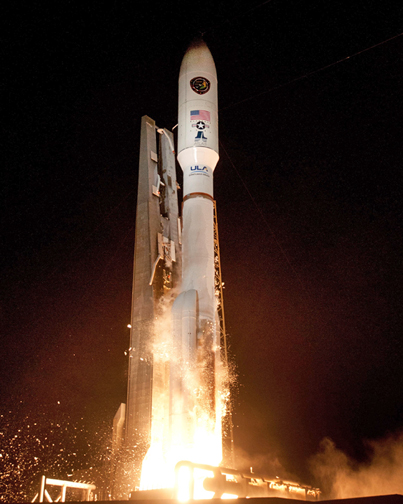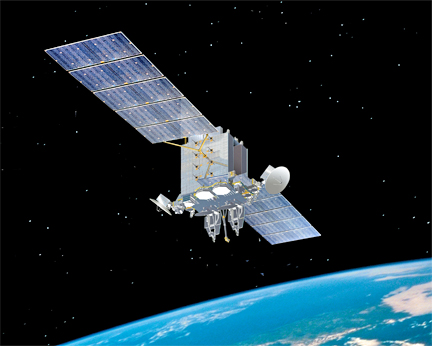
A United Launch Alliance (ULA) Atlas V rocket carrying the third Advanced Extremely High Frequency (AEHF-3) satellite for the United States Air Force lifted off from Space Launch Complex-41 here at 4:10 a.m. EDT today. The AEHF constellation is a joint-service satellite communications system that will provide survivable, global, secure, protected and jam-resistant communications for high-priority military ground, sea and air assets.
(Photo by Pat Corkery, United Launch Alliance)
This was ULA’s 9th launch of an ambitious 12 mission schedule for the year and marks the 40th Atlas V mission and the 75th launch for ULA.
"The United Launch Alliance team is proud to serve alongside our mission partners and privileged that the Air Force has entrusted the ULA team to deliver the critical national security capabilities provided by AEHF-3 to orbit for our soldiers, sailors, airman and Marines around the world,” said Jim Sponnick, ULA vice president, Atlas and Delta Programs.
This mission was launched aboard an Atlas V Evolved Expendable Launch Vehicle (EELV) 531 configuration vehicle, which includes a 5-meter diameter RUAG Space payload fairing along with three Aerojet solid rocket motors attached to the Atlas booster. The Atlas booster for this mission was powered by the RD AMROSS RD-180 engine and the Centaur upper stage was powered by a single Aerojet Rocketdyne RL10A engine.
“Today’s successful launch was the 75th since ULA was formed nearly seven years ago, the 40th Atlas V mission, and the fourth ULA launch in the last two months,” said Sponnick. “The ULA team and our many mission partners emphasize a one-launch-at-a-time focus on mission success along with a strong commitment to continuous improvement—these elements together are the keys to launching our customer’s missions successfully at this unprecedented tempo in a reliable and cost-effective manner.”
The AEHF constellation is a joint-service satellite communications system that will provide survivable, global, secure, protected and jam-resistant communications for high-priority military ground, sea and air assets. Developed by the United States Air Force to provide assured access to space for Department of Defense and other government payloads, the EELV Program supports the full range of government mission requirements, while delivering on schedule and providing significant cost savings over the heritage launch systems. The system also serves international partners, including Canada, the Netherlands and the United Kingdom.
According to a U.S.A.F. Space & Missiles Center info release, the satellite successfully separated from the launch vehicle approximately 51 minutes after liftoff and will now undergo approximately 110 days of orbit-raising operations, followed by approximately 60 days of on-orbit testing. After these critical events, AEHF-3 will be ready to transfer to the 14th Air Force for Satellite Control Authority.
"We are proud of the tremendous efforts by the combined ULA, Lockheed Martin, the SMC and 45th Space Wing military, government civilians and contractors team in making this launch such a success," said Col. Rodney Miller, Chief, Protected SATCOM Division, Military Satellite Communications (MILSATCOM) Systems Directorate. "The satellite is healthy and operating as expected. We have now turned our attention to maneuvering it into its final orbital location over the next several months and look forward to many years of service in providing critical communication capabilities to our warfighters around the world."

Artistic rendition of the AHEF-3 satellite, courtesy of Lockheed Martin Space Systems.
Lockheed Marin's Mark Calassa, vice president of Protected Communications Systems at Lockheed Martin, added, "“The successful launch of the third AEHF satellite is a significant accomplishment for the nation’s protected communications mission. AEHF is functioning well in tests, and allies are connecting to the system for the first time. It shows that our product is meeting mission needs, and we have room to expand capacity for both tactical and strategic users in the future.”
AEHF takes advantage of several Lockheed Martin capabilities to deliver six satellites and a mission control segment. Lockheed Martin contributed payload system engineering, mission control ground software, solar arrays and the A2100 spacecraft bus, which is a dependable and low-risk platform for commercial, civil and military satellites. Both AEHF-1 and AEHF-2 are on orbit, and AEHF-4 through -6 are progressing on schedule. All satellites are assembled at the company’s Sunnyvale, California, facility.
A single AEHF satellite provides greater total capacity than the entire legacy five-satellite Milstar constellation. Individual user data rates will increase five-fold, permitting transmission of tactical military communications, such as real-time video, battlefield maps and targeting data. In addition to its tactical mission, AEHF provides the critical survivable, protected and endurable communications links to national leaders, including presidential conferencing in all levels of conflict.
ATK (NYSE: ATK) provided hardware for the Advanced Extremely High Frequency (AEHF) 3 satellite and the United Launch Alliance (ULA) Atlas V launch vehicle that successfully launched from Cape Canaveral Air Force Station, Florida.
The AEHF 3 is the third satellite in a constellation designed to provide highly secure communications for the military and executive government users for in U.S. and three allied nations. "Ensuring successful Atlas V missions is a critical component of what we do to support ULA," said Joy de Lisser, vice president and general manager of ATK Aerospace Structures. "Our workforce is committed to providing quality components to ULA and serving the U.S warfighter."
The Atlas V rocket flew in the 531 vehicle configuration with a five-meter fairing, three solid rocket boosters and a single-engine Centaur upper stage. Many ATK components and structures also supported the Atlas V rocket:
- Using advanced fiber placement manufacturing and automated inspection techniques, ATK produced three components for the ULA Atlas V 531 vehicle, including the 10-foot diameter composite heat shield that provides essential protection to the first stage engine, the Centaur Interstage Adapter (CISA) that houses the second stage engine, and the Boattail that adapts from the core vehicle to the five-meter diameter fairing. ATK manufactured the structures at its Iuka, Mississippi, facility
- This flight marked the fifth successful flight of the ATK retro motors. Eight of these solid motors supported separation of the spent first stage. The Atlas retrorocket is built at ATK's Missile Defense and Controls facility in Elkton, Maryland
- ATK manufactured the Reaction Control System propellant tank for the Atlas V at its Commerce, California, facility
For the AEHF 3 satellite, ATK provided a host of products:
- The spacecraft bus structure, solar array substrates, yokes and booms were manufactured by ATK's Space Components division, headquartered in San Diego, California Composite structures for the antenna gimbal assemblies, used for precise pointing of the antenna payloads, were manufactured at ATK's Magna, Utah, facility
- Pressurant and propellant tanks for the AEHF propulsion system were manufactured at ATK's Commerce, California, facility
- ATK also provided the heat pipes in support of the bus structure and the payload heat pipes used for cooling the antenna payload suite; both were manufactured at the company's Beltsville, Maryland, facility
ULA's next launch is the Delta IV GPS IIF-5 mission for the Air Force scheduled October 17th from Space Launch Complex-37 at Cape Canaveral Air Force Station, Florida.
ULA program management, engineering, test, and mission support functions are headquartered in Denver, Colorado. Manufacturing, assembly and integration operations are located at Decatur, Alabama, and Harlingen, Texas. Launch operations are located at Cape Canaveral AFS, Florida, and Vandenberg AFB, California.

